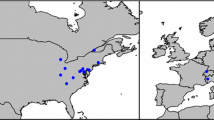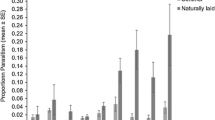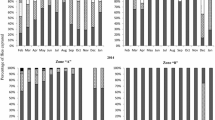Abstract
The impact of alien species on native organisms is a cause for concern worldwide, with biological invasions commonplace today. Suppression efforts targeting many invasive species have included introductions of biological control agents. The numerous releases of biological control agents in the Hawaiian archipelago have resulted in considerable concern for non-target impacts, due to high levels of non-target parasitism observed to occur in some cases. This study investigated the impact of introduced Hymenoptera parasitoids on a Hawaiian moth. The endemic Hawaiian moth Udea stellata (Butler) has seven alien parasitoids associated with it, two purposely introduced, three adventive, and two of uncertain origin. The objective of this study was to determine the relative contribution of the seven parasitoid species to the population dynamics of U. stellata by constructing partial life tables. Marginal attack rates and associated k-values were calculated to allow comparison of mortality factors between experimental sites. Sentinel larvae were deployed on potted host plants and left in the field for 3-day intervals in open and exclusion treatments. The factors that contributed to total mortality in the open treatment were: disappearance (42.1%), death due to unknown reasons during rearing (16.5%) and parasitism (4.9%). The open treatment incurred significantly higher larval disappearance compared to the exclusion treatment (7.8%), which suggests that in large part disappearance is the result of predation. Adventive parasitoids inflicted greater total larval mortality attributable to parasitism (97.0%) than purposely introduced species (3.0%).
Similar content being viewed by others
References
Asquith A, Miramontes E (2001) Alien parasitoids in native forests: the Ichneumonidae wasp community in a Hawaiian rainforest. In: Lockwood J, Howarth F, Purcell M (eds) Balancing nature: assessing the impact of importing non-native biological control agents (an international perspective). Say, Entomologocal Society of America, Lanham, MD
Babendreier D, Bigler F (2005) How to assess non-target effects of polyphagous biological control agents: Trichogramma brassicae as a case study. Proceedings of the 2nd International Conference on Athropod Biological Control, Davos, Switzerland, September 2005, pp 603–610
Barron MC, Wratten SD, Barlow ND (2003) Non-target parasitism of the endemic New Zealand red admiral butterfly (Bassaris gonerilla) by the introduced biological control agent Pteromalus puparium. Biol Control 27:329–335
Babendreier D, Kuske S, Bigler F (2003) Non-target host acceptance and parasitism by Trichogramma brassicae (Hymenoptera: Trichogrammatidae) under laboratory conditions. Biol Control 26:128–138
Barron MC, Wratten SD, Barlow ND (2004) Phenology and parasitism of the red adminal butterfly Bassaris gonerilla (Lepidoptera: Nymphalidae). New Zeal J Ecol 28:105–111
Benson J, Pasquale A, Van Driesche R, Elkinton J (2003a) Assessment of risk posed by introduced braconid wasps to Pieris virginiventris, a native woodland butterfly in New England. Biol Control 26:83–93
Benson J, Van Driesche RG, Pasquale A, Elkinton J (2003b) Introduced braconid parasitoids and range reduction of a native butterfly in New England. Biol Control 28:197–213
Bellows TS Jr, Van Driesche RG, Elkinton JS (1992) Life-table construction and analysis in the evaluation of natural enemies. Annu Rev Entomol 37:587–614
Boettner GH, Elkinton JS, Boettner CJ (2000) Effects of a biological control introduction on three non-target native species of Saturniid moths. Consev Biol 14:1798–1806
Butler AG (1883) On a small series of Lepidoptera from the Hawaiian Islands. Entomol Mon Mag 19:179
Caltagirone LE, Huffaker CB (1980) Benefits and risks of using predators and parasites for controlling pests. Ecol Bull 31:103–109
Carey JR (2001) Insect biodemography. Annu Rev Entomol 46:79–110
DeBach P, Huffaker CB, MacPhee AW (1976) Evaluation of the impact of natural enemies. In: Huffacker CB, Messenger PS (eds) Theory and practice of biological control. Academic press, New York, p 778
Duan JJ, Messing RH (1996) Response of two opine fruit fly parasitoids (Hymenoptera: Braconidae) to the lantana gall fly (Diptera: Tephritidae). Environ Entomol 25:1428–1437
Duan JJ, Messing RH (2000) Evaluating non-target effects of classical biological control: fruit fly parasitoids in Hawaii as a case study. In: Follet PA, Duan JJ (eds) Non-target effects of biological control. Kluwer, Norwell, pp 95–109
Duan JJ, Purcell MF, Messing RH (1998) Association of the opiine parasitoid Diachasmimorpha tryoni (Hymenoptera: Braconidae with the lantana gall fly (Diptera: Tephritidae) on Kauai. Environ Entomol 27:419–426
Elkinton JS, Buonaccorsi JP, Bellows TS, Van Driesche RG (1992) Marginal attack rate, k-values and density dependence in the analysis of contemporaneous mortality factors. Res Popul Ecol 34:29–44
Follett PA, Duan J, Messing RH, Jones VP (2000) Parasitoid drift after biocontrol introductions: re-examining Pandora’s box. Am Entomol 46:82–94
Fullaway DT, Krauss NLH (1945) Common insects of Hawaii. Tongg, Honolulu, p 228
Funasaki GY, Lai P, Nakahara LM, Beardsley JW, Ota A (1988) A review of biological control introductions in Hawaii: 1890 to 1988. Proc Hawaiian Entomol Soc 28:105–160
Furlong MJ, Shi Z, Liu S, Zalucki MP (2004) Evaluation of the impact of natural enemies on Plutella xyllostella L. (Lepidoptera: Yponomeutidae) populations on commercial brassica farms. Agric For Entomol 6:311–322
Gagne WC, Howarth FG (1985) Conservation status of the endemic Hawaiian lepidoptera. In: Proceedings of the 3rd Congress of European Lepidopterologists, Cambridge (1982) Societus Europaea Lepidopterologica, Karluhe, pp 74–84
Henneman ML, Memmott J (2001) Infiltration of a Hawaiian community by introduced biological control agents. Science 293:1314–1316
Hoddle MS (2004) Restoring balance: using exotic natural enemies to control invasive exotic species. Conserv Biol 18:38–49
Howarth FG (1983) Classical biocontrol: panacea or Pandora’s box? Proc Hawaiian Entomol Soc 24:239–244
Howarth FG (1991) Environmental impacts of classical biological control. Annu Rev Entomol 36:485–509
Johnson MT, Follett PA, Taylor AD, Jones VP (2005) Impacts of biological control and invasive species on a non-target native Hawaiian insect. Oecologia 142:529–540
Kaneshiro KY (1995) Evolution, speciation, and the genetic structure of island populations. In: Vitousek P, Andsersen H, Loope L (eds) Islands: biological diversity and ecosystem function. Springer, New York, pp 23–34
Kaufman LV (2008) Non-target impacts of introduced parasitoids and validation of probabilistic risk assessment for biological control introductions. Doctoral dissertation, Entomology, University of Hawaii at Manoa
Kaufman LV, Wright MG (in press) Life history, seasonal phenology and parasitoids of the Hawaiian endemic moth Udea stellata (Lepidoptera: Crambidae). Ann Entomol Soc Am 120
Kellogg SK, Fink LS, Brower LP (2003) Parasitism of native luna moths, Actia luna (L.) (Lepidoptera: Saturniidae) by the introduced Compsilura concinnata (Meigen) (Diptera: Tachinidae) in central Virginia, and their hyperparasitism by Trigonalid wasps (Hymenoptera: Trigonalidae). Environ Entomol 32:1019–1027
Loope LL, Howarth FG (2003) Globalization and pest invasion: where will we be in five years? In: Proceedings of the international symposium on biological control of arthropods, Honolulu, Hawaii, January 2002, United States. Department of Agriculture, Forest Service, Morgantown, West Virginia, FHTET-2003–05, pp 34–39
Louda SM, Pemberton RW, Johnson MT, Follett PA (2003) Non-target effects––the Achilles heel of biological control? retrospective analysis to reduce risk associated with biological control introductions. Annu Rev Entomol 48:365–396
Messing RH, Wright MG (2006) Biological control of invasive species: solution or pollution. Front Ecol Environ 4:132–140
Midega CAO, Ogol CKPO, Overholt WA (2005) Life table, key factor analysis and density relations of natural populations of the spotted maize stemborer, Chilo partellus (Lepidoptera: Crambidae), under different cropping systems at the Kenyan coast. Int J Trop Ins Sci 25:86–95
Morris RF (eds) (1963) The dynamics of epidemic spruce budworm populations. Mem Ent Soc Can 31:223–228
Morris RF, Miller CA (1954) A development of life-tables for the spruce budworm. Can J Zool 32:283–301
Nishida GM (2002) Hawaiian terrestrial arthropod checklist, 4th edn. Technical report 22 BP. Bishop Museum, Honolulu, Hawaii, p 263
Oboyski PT, Slotterback JW, Banko PC (2004) Differential parasitism of seed-feeding Cydia (Lepidoptera: Tortricidae) by native and alien wasp species relative to elevation in subalpine sophora (Fabaceae) forests on Mauna Kea, Hawaii. J Insect Conserv 8:229–240
Peck RW, Banko PC, Schwarzfeld M, Euaparadorn M, Brink KW (2008) Alien dominance of the parasitoid wasp community along an elevation gradient on Hawai’i Island. Biol Invas, online first version
Perkins RCL (1897) The introduction of beneficial insects into the Hawaiian Islands. Nature 55:499–500
Royama T (1981) Evaluation of mortality factors in life-table analysis. Ecol Monogr 5:495–505
Simberloff D (1992) Conservation of pristine habitats and unintended effects of biological control. In: Kauffman WC, Nichols JE (eds) Selection criteria and ecological consequences of importing natural enemies. Entomological Society of America, Say, Lanham, pp 103–117
Simberloff D, Stiling P (1996) How risky is biological control? Ecology 77:1965–1974
Simmonds FJ, Bennett FD (1977) Biological control of agricultural pests. Proceedings of the XV International Congress in Entomology, pp 464–472
Stein JD (1983) The biology, host range, parasites, and hyperparasites of koa seed insects in Hawaii: a review. Proc Hawaiian Entomol Soc 24(2/3):317–326
Stiling P, Simberloff D (2000) The frequency and strength of non-target effects of invertebrate biological control agents on plant pests and weeds. In: Follett PA, Duan JJ (eds) Non-target effects of biological control. Kluwer, Boston, pp 31–43
Wright MG, Hoffmann MP, Kuhar TP, Gardner J, Pitcher SA (2005) Evaluating risks of biological control introductions: a probabilistic risk-assessment approach. Biol Control 35:338–347
Van den Bosch R, Messenger PS (1973) Biological control. Intext, New York, p 180
Van Driesche RG, Bellows TS, Elkinton JS, Gould JR, Ferro DN (1991) The meaning of percentage parasitism revisited: solutions to the problem of accurately estimating total losses from parasitism. Environ Entomol 20:1–7
Van Driesche RG, Nunn C, Pasquale A (2004) Life history pattern, host plants and habitat as determinants of population survival of Pieris napi oleracea interacting with an introduced braconid parasitoid. Biol Control 29:278–287
Van Lenteren JC, Bale J, Bigler F, Hokkanen HMT, Loomans AJM (2006) Assessing risks of releasing exotic biological control agents of arthropod pests. Annu Rev Entomol 51:609–634
Acknowledgments
The authors would like to acknowledge the USDA-TSTAR grant program for funding. The Hawaii Department of Land and Natural Resources and the Nature Conservancy of Hawaii are thanked for facilitating collection permits and access to field sites. Peter Follett and Tracy Johnson are thanked for reviewing an earlier version of the manuscript. Roy Van Driesche is thanked for advice on life table analysis. Numerous field assistants are thanked for their help in field collections, as well as Clesson Higashi and Sasha Grant for helping to rear the larvae and growing the plants used in this study.
Author information
Authors and Affiliations
Corresponding author
Additional information
Communicated by Thomas Hoffmeister.
Rights and permissions
About this article
Cite this article
Kaufman, L.V., Wright, M.G. The impact of exotic parasitoids on populations of a native Hawaiian moth assessed using life table studies. Oecologia 159, 295–304 (2009). https://doi.org/10.1007/s00442-008-1226-4
Received:
Accepted:
Published:
Issue Date:
DOI: https://doi.org/10.1007/s00442-008-1226-4




